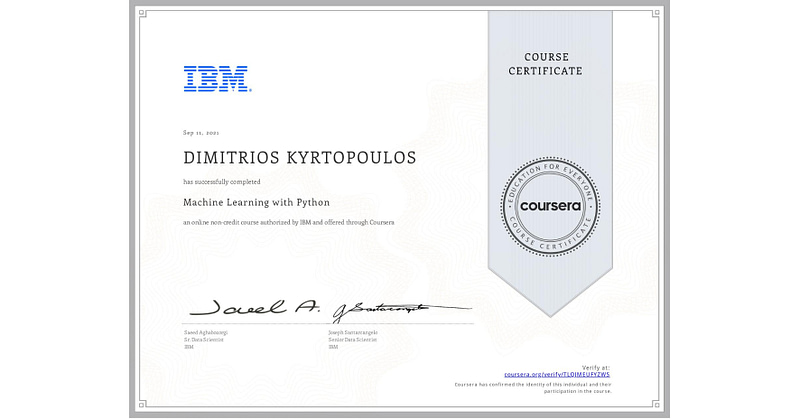IBM Machine Learning with Python
Instructors
About this Course
This course dives into the basics of machine learning using an approachable, and well-known programming language, Python.
In this course, we will be reviewing two main components: First, you will be learning about the purpose of Machine Learning and where it applies to the real world. Second, you will get a general overview of Machine Learning topics such as supervised vs unsupervised learning, model evaluation, and Machine Learning algorithms. In this course, you practice with real-life examples of Machine learning and see how it affects society in ways you may not have guessed!
What you will learn
Give examples of Machine Learning in various industries.
Outline the steps machine learning uses to solve problems.
Provide examples of various techniques used in machine learning.
Describe the Python libraries for Machine Learning.
Skills you will gain
Python Libraries
Machine Learning
regression
Hierarchical Clustering
K-Means Clustering
Syllabus
Week 1: Introduction to Machine Learning
In this module, you will learn about applications of Machine Learning in different fields such as health care, banking, telecommunication, and so on. You’ll get a general overview of Machine Learning topics such as supervised vs unsupervised learning, and the usage of each algorithm. Also, you understand the advantage of using Python libraries for implementing Machine Learning models.
Week 2: Regression
In this module, you will get a brief intro to regression. You learn about Linear, Non-linear, Simple and Multiple regression, and their applications. You apply all these methods on two different datasets, in the lab part. Also, you learn how to evaluate your regression model, and calculate its accuracy.
Week 3: Classification
In this module, you will learn about classification technique. You practice with different classification algorithms, such as KNN, Decision Trees, Logistic Regression and SVM. Also, you learn about pros and cons of each method, and different classification accuracy metrics.
Week 4: Clustering
In this module, you will learn about different clustering approaches. You learn how to use clustering for customer segmentation, grouping same vehicles, and also clustering of weather stations. You understand 3 main types of clustering, including Partitioned-based Clustering, Hierarchical Clustering, and Density-based Clustering.
Week 5: Recommender Systems
In this module, you will learn about recommender systems. First, you will get introduced with main idea behind recommendation engines, then you understand two main types of recommendation engines, namely, content-based and collaborative filtering.
Week 6: Final Project
In this module, you will do a project based of what you have learned so far. You will submit a report of your project for peer evaluation.

